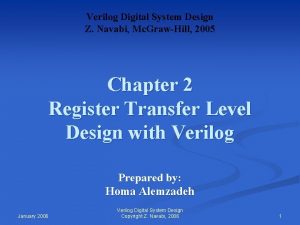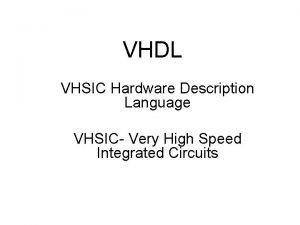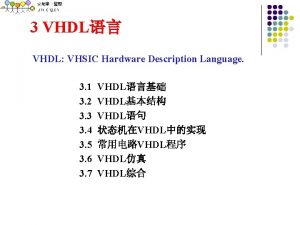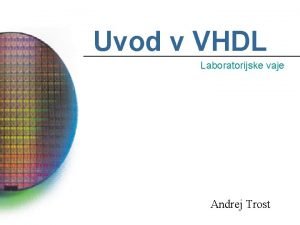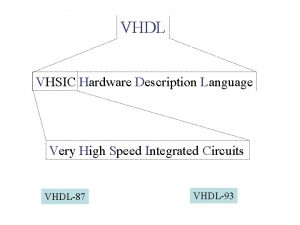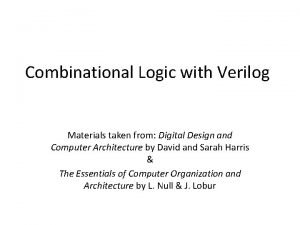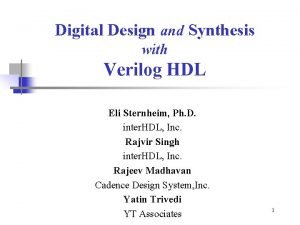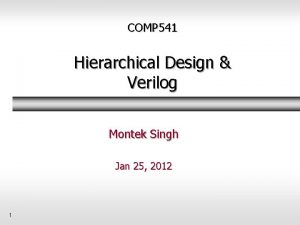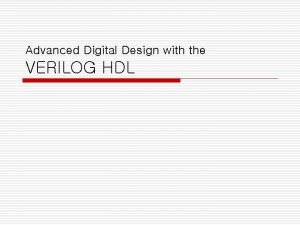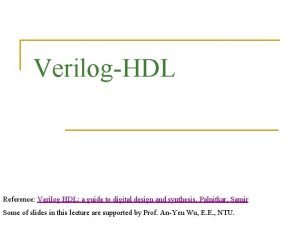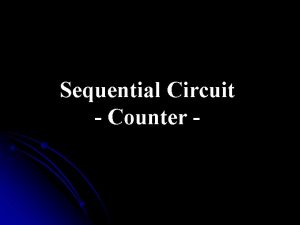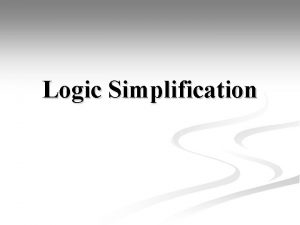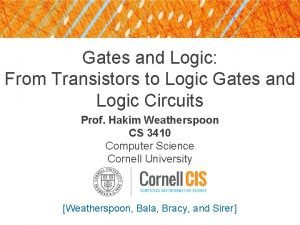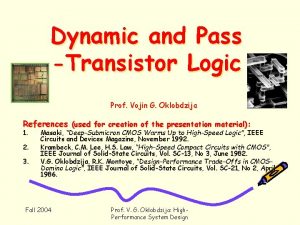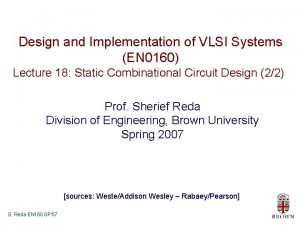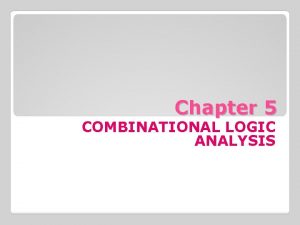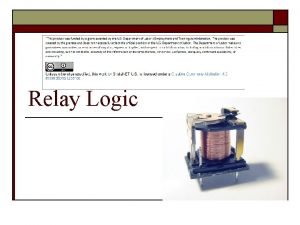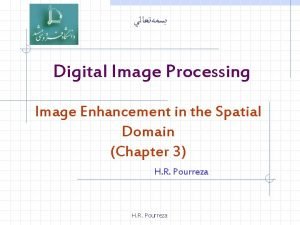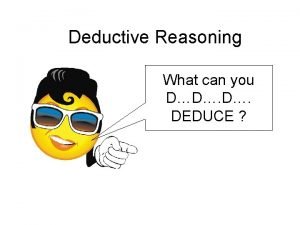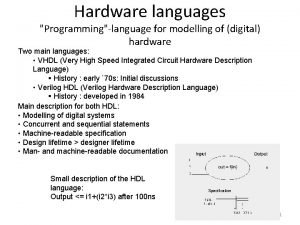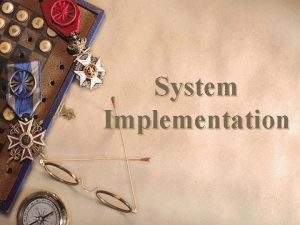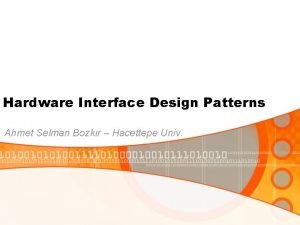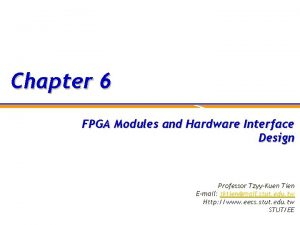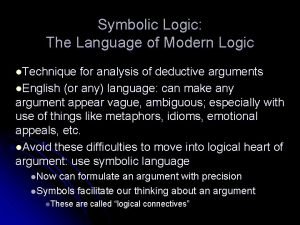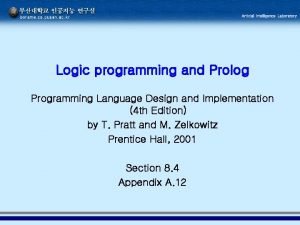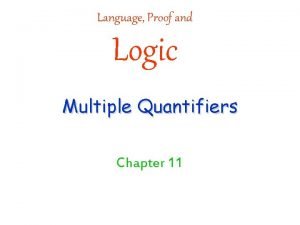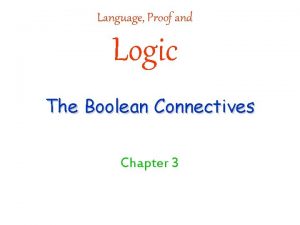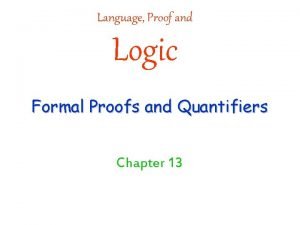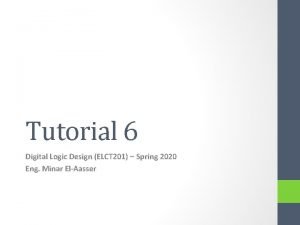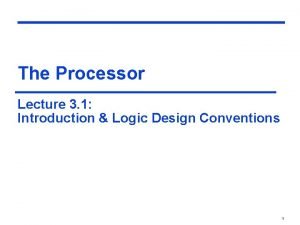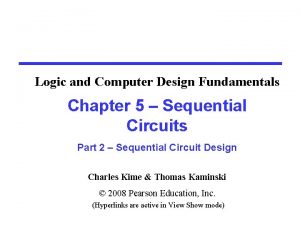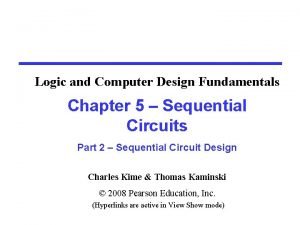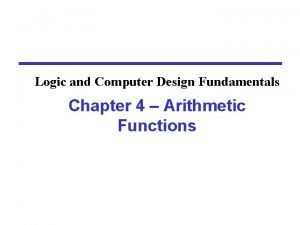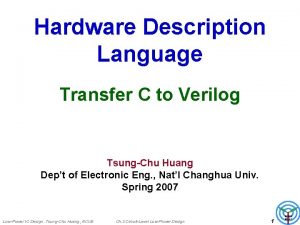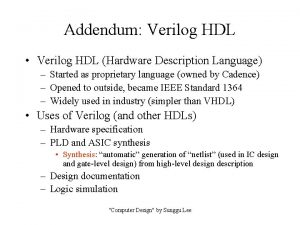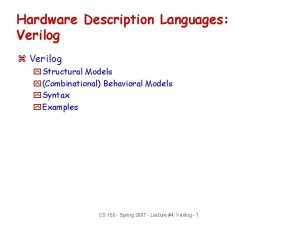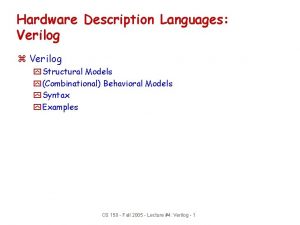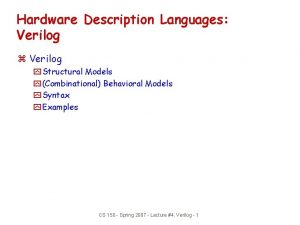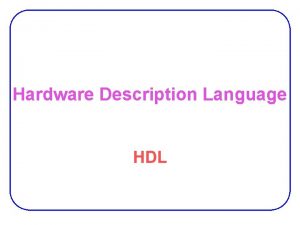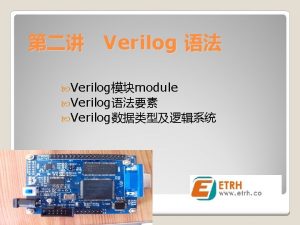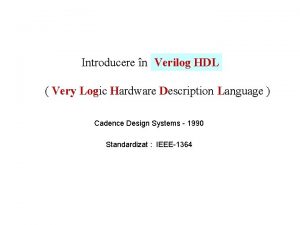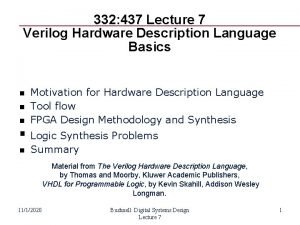Hardware Description Language Logic Design using Verilog TsungChu









![Coding by V 95 #include <stdio. h> MCell M 0(A[0], B[0], 0, C[0], 0, Coding by V 95 #include <stdio. h> MCell M 0(A[0], B[0], 0, C[0], 0,](https://slidetodoc.com/presentation_image_h/bf9e8957db7fcaa60a04240854f5a1af/image-10.jpg)




















![For Instance begin N← 0; A← 0; B←Y; C← 0 B[0] No Yes {C, For Instance begin N← 0; A← 0; B←Y; C← 0 B[0] No Yes {C,](https://slidetodoc.com/presentation_image_h/bf9e8957db7fcaa60a04240854f5a1af/image-31.jpg)





![Map to ALU begin Initial: N← 0; A← 0; B←Y; C← 0 dummy B[0] Map to ALU begin Initial: N← 0; A← 0; B←Y; C← 0 dummy B[0]](https://slidetodoc.com/presentation_image_h/bf9e8957db7fcaa60a04240854f5a1af/image-37.jpg)









![From C Straightforward to Verilog Example: Bubble Sorter int Sort(int M[], N) { int From C Straightforward to Verilog Example: Bubble Sorter int Sort(int M[], N) { int](https://slidetodoc.com/presentation_image_h/bf9e8957db7fcaa60a04240854f5a1af/image-47.jpg)

![From C Straightforward to Verilog Example: Prime Numbers void prime() { unsigned int M[100], From C Straightforward to Verilog Example: Prime Numbers void prime() { unsigned int M[100],](https://slidetodoc.com/presentation_image_h/bf9e8957db7fcaa60a04240854f5a1af/image-49.jpg)

- Slides: 50

Hardware Description Language -- Logic Design using Verilog Tsung-Chu Huang Dept. of Electronic Eng. National Changhua University of Ed. Email: tch@cc. ncue. edu. tw 2015/10/15 HDL T. -C. Huang / NCUE Fall 2015 1

Outline Ø Ø HDL T. -C. Huang / NCUE Fall 2015 RTL or Behavioral Two Major Phases of HDL Applicative Tools Related to HDL ASM-Based Synthesis using an Example 2

Which is Better – RTL or Behavior Rethink using Binary Counter and Gray Counter Q 5 Q 4 Q 3 Q 2 Q 1 Q 0 module input output wire Binary(Clk, Q); Clk; [n-1: 0] Qb; always@(posedge Clk) Q=Q+1; Low Power Channel endmodule input output wire Gray(Clk, Q); Clk; [n-1: 0] Qb; binary_counter (Clk, Qb); xor_array (Q, Qb); endmodule Regular structure or regular behavior? HDL T. -C. Huang / NCUE Fall 2015 3

Two Major Phases Ø Simulation 1. Usually simulated along time axis (initial) 2. With stimuli Ø Synthesis 1. Continuously exists • Gate-Level (Structural View) • RTL ( assign L = f(R); ) 2. Always Procedural (Behavioral Model) HDL T. -C. Huang / NCUE Fall 2015 4

Sequential Circuits Ø Huffman Model: Combinational Circuits with a set of DFFs 1. Combinational Network is a DAG (Directed Acyclic Graph) 2. 1 -Cycle FSM with additional Reset cycle. 3. Can be expanded to an iterative logic array (ILA) that is a combinational circuit, i. e. trivial 0 -cycle FSM. 4. Long critical paths can be spitted by inserted DFFs. Critical-Path Split Seq. Ckt Datapath ASM Huffman Model Pure FSM ILA Pipelined Datapath Combinational Circuits HDL T. -C. Huang / NCUE Fall 2015 5

Considering Subtractors A Bout B – Bin module Sub(A, B, Bi, D, Bo); input A[n-1: 0], Bi; output D[n-1: 0], Bo; reg D[n-1: 0], Bo; assign {Bo, Bi}=A-B-Bi; endmodule D Ø Ø HDL Boolean Function Based Design: Too Complex Half-Subtractor→Full-Subtractor→n-bit Subtractor Parallel Design Modified from Adder: • S = A + B if Sub==0 • S =A - B = A + (-B) = A + (~B+1) if Sub==1 → D = S = A + (Sub ? ~B : B) + Sub T. -C. Huang / NCUE Fall 2015 6

6 -Bit Parallel Multiplier 2 3 4 1 0 1 1 =B X) 1 2 3 X) 1 1 0 1 =A 7 0 2 4 6 8 2 3 4 2 8 7 8 2 HDL T. -C. Huang / NCUE Fall 2015 1→ 1 0 1 1 0→ 0 0 1→ 1 0 1 1 1 0 0 0 1 1 Product P=Bx. A 7

Multiplier Cell module MULij(Ai, Bj, Ci, Co, Pi, Po); input Ai, Bj, Ci; output Co, Pij; Bj and (AB, Ai, Bj); Full. Adder (Pi, Ci, AB, Co, Po); endmodule Ai + Cij Ci(j-1) Pij HDL T. -C. Huang / NCUE Fall 2015 8

6 -Bit Parallel Multiplier HDL T. -C. Huang / NCUE Fall 2015 9
![Coding by V 95 include stdio h MCell M 0A0 B0 0 C0 0 Coding by V 95 #include <stdio. h> MCell M 0(A[0], B[0], 0, C[0], 0,](https://slidetodoc.com/presentation_image_h/bf9e8957db7fcaa60a04240854f5a1af/image-10.jpg)
Coding by V 95 #include <stdio. h> MCell M 0(A[0], B[0], 0, C[0], 0, S[0]); #include <stdlib. h> MCell M 1(A[0], B[1], C[0], C[1], 0, S[1]); main() MCell M 2(A[0], B[2], C[1], C[2], 0, S[2]); { MCell M 3(A[0], B[3], C[2], C[3], 0, S[3]); int i, j, N=6; MCell M 4(A[0], B[4], C[3], C[4], 0, S[4]); MCell M 5(A[0], B[5], C[4], C[5], 0, S[5]); for(i=0; i<N; i++) { MCell M 6(A[1], B[0], 0, C[6], S[1], S[6]); for(j=0; j<N; j++) { MCell M 7(A[1], B[1], C[6], C[7], S[2], S[7]); printf("MCell M%d(A[%d], B[%d], ", i*N+j, i, j); MCell M 8(A[1], B[2], C[8], S[3], S[8]); if(j==0) printf("0, "); else printf("C[%d], ", C[7], i*N+j-1); MCell M 9(A[1], B[3], C[8], C[9], S[4], S[9]); printf("C[%d], ", i*N+j); MCell M 10(A[1], B[4], C[9], C[10], S[5], S[10]); if(i==0) printf("0, "); MCell M 11(A[1], B[5], C[10], C[11], C[5], S[11]); else if(j==N-1) printf("C[%d], (i-1)*N+j); MCell ", M 12(A[2], B[0], 0, C[12], S[7], S[12]); MCell M 13(A[2], B[1], C[12], C[13], S[8], S[13]); else printf("S[%d], ", (i-1)*N+j+1); MCell M 14(A[2], B[2], C[13], C[14], S[9], S[14]); printf("S[%d]); n", i*N+j); MCell M 15(A[2], B[3], C[14], C[15], S[10], } S[15]); } MCell M 16(A[2], B[4], C[15], C[16], S[11], } S[16]); MCell M 17(A[2], B[5], C[16], C[17], C[11], S[17]); MCell M 18(A[3], B[0], 0, C[18], S[13], S[18]); MCell M 19(A[3], B[1], C[18], C[19], S[14], S[19]); MCell M 20(A[3], B[2], C[19], C[20], S[15], S[20]); MCell M 21(A[3], B[3], C[20], C[21], S[16], S[21]); MCell M 22(A[3], B[4], C[21], C[22], S[17], S[22]); MCell M 23(A[3], B[5], C[22], C[23], C[17], S[23]); MCell M 24(A[4], B[0], 0, C[24], S[19], S[24]); MCell M 25(A[4], B[1], C[24], C[25], S[20], S[25]); MCell M 26(A[4], B[2], C[25], C[26], S[21], HDL T. -C. Huang / NCUE Fall 2015 S[26]); 10

Enhancement in IEEE 1364 -2001 V 2 K 1. Design management—Verilog configurations 2. Scalable models—Verilog generate 3. Constant functions 4. Indexed vector part selects 5. Multidimensional arrays (reg [7: 0] a[1: 4][0: 255]; ) 6. Bit and part selects within arrays 7. Signed arithmetic extensions (eg. reg signed [15: 0] x; >>>) 8. Power operator ** (xor ^) 9. Re-entrant tasks and recursive functions 10. Combinational logic sensitivity token (always@*) 11. Comma-separated sensitivity lists 12. Automatic width extension beyond 32 bits 13. Enhanced file I/O 14. In-line parameter passing by name 15. Combined port and data type declarations 16. ANSI-style input and output declarations 17. reg declaration initial assignments HDL T. -C. Huang / NCUE Fall 2015 11

Coding by V 2 K // Nx. N Parallel Multiplier // Based on IEEE Standard 1364 -2001 module MUL(A, B, P); parameter N = 8; input [N-1: 0] A, B; output [2*N-1: 0] P; wire Ci[0: N-1], Co[0: N-1], Si[0: N-1], So[0: N-1]; genvar i, j; for(i=0; i<N; i=i+1) begin : Row for(j=0; j<N; j=j+1) begin : Col MCell( A[i], B[j], Ci[i][j], Co[i][j], Si[i][j], So[i][j]); if(j==0) begin assign Ci[i][j]=1'b 0; assign P[i] = So[i][j]; end else begin assign Ci[i][j]=Co[i][j-1]; if(i==N-1) assign P[N+j-1] = So[i][j]; end if(i==0) assign Si[i][j]=1'b 0; else if(j==N-1) assign Si[i][j]=Co[i-1][j]; else assign Si[i][j] = So[i-1][j+1]; end module MCell(A, B, Ci, Co, Si, So); end input A, B, Ci, Si; assign P[2*N-1] = Co[N-1]; output Co, So; wire D, DC, CS, SD; endmodule and g 1(D, A, B); xor g 2(So, D, Ci, Si); and g 3(DC, D, Ci); and g 4(CS, Ci, Si); and g 5(SD, Si, D); or g 6(Co, DC, CS, SD); endmodule HDL T. -C. Huang / NCUE Fall 2015 12

Coding by V 2 K genvar i, j; for(i=0; i<N; i=i+1) begin : Row for(j=0; j<N; j=j+1) begin : Col MCell( A[i], B[j], Ci[i][j], Co[i][j], Si[i][j], So[i][j]); end endmodule HDL T. -C. Huang / NCUE Fall 2015 13

Coding by V 2 K genvar i, j; for(i=0; i<N; i=i+1) begin : Row for(j=0; j<N; j=j+1) begin : Col if(j==0) begin assign Ci[i][j]=1'b 0; assign P[i] = So[i][j]; end HDL T. -C. Huang / NCUE Fall 2015 14

Coding by V 2 K genvar i, j; for(i=0; i<N; i=i+1) begin : Row for(j=0; j<N; j=j+1) begin : Col if(j==0) else begin assign Ci[i][j]=Co[i][j-1]; if(i==N-1) assign P[N+j-1] = So[i][j]; end HDL T. -C. Huang / NCUE Fall 2015 15

Coding by V 2 K genvar i, j; for(i=0; i<N; i=i+1) begin : Row for(j=0; j<N; j=j+1) begin : Col if(i==0) assign Si[i][j]=1'b 0; else if(j==N-1) assign Si[i][j]=Co[i-1][j]; else assign Si[i][j] = So[i-1][j+1]; end assign T. -C. Huang /P[2*N-1] NCUE Fall 2015 = Co[N-1]; HDL 16

Big-Data Verification `timescale 1 ns/10 ps module Test_MUL; parameter N = 8; reg [N-1: 0] A, B; wire [2*N-1: 0] P; MUL U 1(A, B, P); integer i, j, ok; initial begin $monitor($time, ", ", A, ", ", B, ", ", P); ok=1; for(i=0; i < 1<<N ; i=i+1) for(j=0; j < 1<<N ; j=j+1) begin A=i; B=j; #10; if(P != i*j) ok=0; end $display("Varification: %s. ", ok ? "Ok" : "Failed"); $stop; VSIM 3> run end # 0, 0, 0, 0 : endmodule : # 655340, 255, 254, 64770 # 655350, 255, 65025 # Varification: Ok. # Break in Module Test_MUL at D: /work/Mul. Array/Test_MUL. v line 20 HDL T. -C. Huang / NCUE Fall 2015 VSIM 4> | 17

Layout View: 6 -Bit Parallel Multiplier HDL T. -C. Huang / NCUE Fall 2015 18

N-bit Shifter 1 Shift_Left 1 0 1 0 1 0 Shift_Left 2 0 1 0 1 1 Shift_Left 3 0 1 0 1 Constant Shifter Shift Register HDL T. -C. Huang / NCUE Fall 2015 19

Algorithmic State Machine Ø Ø HDL A special design style of general finite state machines. It can be designed by mapping from the flow-chart. It can be synthesized manually. High area overhead and low performance due multiplexer stack. 1. Describe your system in pseudo code; 2. Draw the flow-chart; 3. Map the flow-chart to ASM chart; 4. Map the ASM chart to the HDL or circuit. T. -C. Huang / NCUE Fall 2015 20

Pseudo Code • • HDL A high-level, almostexecutable description Used for leader’s instruction, explanation of algorithms, etc. Pascal-like or C-like codes with some comprehensive English is preferable. Example: T. -C. Huang / NCUE Fall 2015 21

Basic Flowchart Elements HDL • Flow and Direction: • Decision: • Process: • Terminals: begin • (Card) Input: card in • Specific Outputs: T. -C. Huang / NCUE Fall 2015 condition N process tapeout Y end report display 22

Sequence Control if-then-else if ( C ) { Y } else { N } Condition Y Y N N HDL T. -C. Huang / NCUE Fall 2015 23

Sequence Control switch c 1 2 N if (expr==const 1) {P 1} else if (expr==const 2) {P 2} else if (expr==const 3) {P 3} else if (expr==const 4) {P 4} else {Pdefault} 3 switch (expr) { case const 1: case const 2: case const 3: case cosnt 4: . . . default: } HDL T. -C. Huang / NCUE Fall 2015 {P 1} {P 2} {P 3} {P 4} break; {Pdefault} 24

Sequence Control For-loop Initialization for ( I ; C ; N ) { P } Y Condition Process Next N for(i=1; i<=9; i++) { for(j=1; j<=9; j++) printf(“%d. X%d=%2 dt”, i, j, i*j); printf(“n”); } HDL T. -C. Huang / NCUE Fall 2015 25

Sequence Control Do-While-Loop and While-Do-Loop do { P } while( C } ; while ( ) C { P }; Process Condition N HDL T. -C. Huang / NCUE Fall 2015 Y Condition Y Process N 26

Map Flowchart to ASM Chart Ø Split Processes in flowchart into States that each state can be executed in 1 clock cycle. Ø Note that a WR-dependent process should be split into two states. a = b + c; State 1: a = b + c; (write first then read) x = a * d; State 2: x = a * d; x = a + d; (read first then write) a = b * c; HDL T. -C. Huang / NCUE Fall 2015 State 1: x = a + d; a = b * c; 27

Map Decision to Demultiplexer Ø If the condition is a 1 -bit variable, directly map the decision to a demultiplexer that is a combinational gate (i. e. , it takes a delay less than the clock cycle). C Y 1 C N 0 Ø The clock state of a decision is belong to the last process, therefore the last process should be split into 2 states if there is a WR-dependency. C = A & B; C N HDL T. -C. Huang / NCUE Fall 2015 (Dummy) Y 1 C 0 28

Map Decision with Expression to Diamond Ø If the condition is an expression instead of a direct input, map the decision to a a diamond. Ø A diamond is composed of a demultiplexer and an extra process. C=f( ) N Y 1 f(C) f( ) C 0 1 0 Ø When the dealy of combinational circuit f( ) is too large, it is better to split it to two states with a demultiplexer. C = f( ); (Dummy) 1 C HDL T. -C. Huang / NCUE Fall 2015 0 29

Example 8 -bit Multiplier X Y N Rst C A B Clk HDL T. -C. Huang / NCUE Fall 2015 30
![For Instance begin N 0 A 0 BY C 0 B0 No Yes C For Instance begin N← 0; A← 0; B←Y; C← 0 B[0] No Yes {C,](https://slidetodoc.com/presentation_image_h/bf9e8957db7fcaa60a04240854f5a1af/image-31.jpg)
For Instance begin N← 0; A← 0; B←Y; C← 0 B[0] No Yes {C, A}←A + X {C, A, B}←{C, A, B}>>1 N←N+1 No N=0 Yes end HDL T. -C. Huang / NCUE Fall 2015 X=151 1 0 0 1 1 1 1 0 0 1 Y=165 N 000 00 0 0 0 010100101 B 00001001011110100101 + 00100100101111010010 → 00100100101111010010 01000010010111101001 → 01001011110011101001 + 01100101111001110100 → 01100101111001110100 10000010111100111010 → 100000101111001110100001011110011101 → 1010111010011101 + 11000101011101001110 → 110001010111010011100010101110100111 → 11101100001010100111 + 00000110000101010011 → 31

Example of Verification using C #include <stdio. h> main() { unsigned char X, Y, C, A, B, N, Verified; int i, P, Q, Acc, S; Verified = 1; for(i=0; i<(1<<16); i++){ X=i/(1<<8); Y=i%(1<<8); P=X*Y; // Golden Circuit // Algorithm Started Here N=0; A=0; B=Y; C=0; // Initialization do { // Accumulate if(B%2) {Acc = A + C*256 + X; A=Acc%256; C=(Acc>>8)%2; } // Shift CAB S = C*65536 + A*256 + B; S = S >> 1; B=S%256; A=(S>>8)%256; C=(S>>16)%2; N++; } while(N!=8); Q=(A<<8)+B; if(Q!=P) { Verified=0; printf("Error when X=%d, Y=%d, Q=%dn", X, Y, Q); break; } } HDL } if(Verified) printf("The circuit is exhaustively functionally verified. n"); T. -C. Huang / NCUE Fall 2015 32

Example: Verified using Assembly Language BEGIN: LOOP: SHIFT: MOV CLR MOV JE ADC SHR DEC JNZ END N, #States A C B, X SHIFT Y CAB N LOOP C and Assembly codes can be the fast logic simulator. HDL T. -C. Huang / NCUE Fall 2015 33

Example: 8 -bit Multiplier begin Initial: N← 0; A← 0; B←Y; C← 0 begin N← 0; A← 0; B←Y; C← 0 B[0] No Yes {C, A}←A + X {C, A, B}←{C, A, B}>>1 N←N+1 No N=0 Yes end dummy B[0] 1 Accumulate: {C, A}←A + X Shift: {C, A, B}←{C, A, B}>>1; N←N+1 Dummy 2: Dummy 0 N=0 1 end ASM Chart HDL T. -C. Huang / NCUE Fall 2015 0 34

Map ASM Elements to Sequencer D D PRE begin State Q CLR Q State 1 C C 0 1 0 f( ) 1 f( ) C 0 1 0 end D CLR Q HDL T. -C. Huang / NCUE Fall 2015 35

Map to State Sequencer D PRE Q begin Initial: N← 0; A← 0; B←Y; C← 0 D CLR Q Initial D CLR dummy Q B[0] 0 1 Accumulate: {C, A}←A + X 0 1 D CLR Accumulate Q Shift: {C, A, B}←{C, A, B}>>1; N ← N + 1 D CLR Q dummy 0 N=0 Shift D CLR Q 1 end ASM Chart HDL T. -C. Huang / NCUE Fall 2015 0 1 D CLR Q 36
![Map to ALU begin Initial N 0 A 0 BY C 0 dummy B0 Map to ALU begin Initial: N← 0; A← 0; B←Y; C← 0 dummy B[0]](https://slidetodoc.com/presentation_image_h/bf9e8957db7fcaa60a04240854f5a1af/image-37.jpg)
Map to ALU begin Initial: N← 0; A← 0; B←Y; C← 0 dummy B[0] Shift 0 1 Accumulate: {C, A}←A + X 0 Accumulate + 1 0 0 Shift 1 Accumulate 1 1 0 0 Initial 0 1 Shift 0 Initial C 0 1 Initial A 0 1 B Shift: {C, A, B}←{C, A, B}>>1; N ← N + 1 1 + dummy Shift 0 end 1 0 N=0 1 0 Initial 0 1 N ASM Chart HDL T. -C. Huang / NCUE Fall 2015 37

Control Y D PRE X Q D CLR Q Initial D CLR Shift 0 + 1 0 Shift 1 Q Accumulate 0 1 Accumulate 1 0 0 Initial 1 0 1 Initial C D CLR Shift 0 0 0 1 Initial A 0 1 B Accumulate Q P D CLR Q + Shift D CLR 0 1 0 Q Initial 0 Ready 1 0 1 N 1 0 Rst Clk HDL D CLR T. -C. Huang / NCUE Fall 2015 Q = 38

Remapped to Coding Gate-Level Model for Sequencer module Sequencer(Rst, Clk, B, E, Initial, Accumulate, Shift, Ready); input Rst, Clk, B, E; output Initial, Accumulate, Shift, Ready; DFFp (Clk, Rst, 0, Q 1) DFFc (Clk, Rst, Q 1, Initial); DFFc (Clk, Rst, initial, Q 2); or (A, Q 2, E 0); mux (B, A, B 1, B 0); DFFc (Clk, Rst, B 1, Accumulate); or (Q 3, B 0, Accumulate) DFFc (Clk, Rst, Q 3, Shift); DFFc (Clk, Rst, Shift, Q 4); mux (E, Q 4, E 1, E 0); or (Q 5, Ready, E 1); DFFc (Clk, Rst, Q 5, Ready); endmodule HDL T. -C. Huang / NCUE Fall 2015 39

Remapped to Coding Minimized Counter-Based State Diagram Init ower. On or Sys. Rst Init HDL T. -C. Huang / NCUE Fall 2015 Acc N Shift 40

Counter-Based FSM Coding 2 -State-Cycle 2 n-Bit Sequential Multiplier module MUL(Rst, Clk, X, Y, P, Ready); Parameter n=3; input Rst, Clk; input [2^n-1: 0] X, Y; output [2*2^n-1: 0] P; output Ready; reg [n-1: 0] N reg C; reg [2*2^n-1: 0] P; reg [1: 0] State; parameter Init=2’b 00, Acc=2’b 01, Shift=2’b 10, Ready=2’b 11; always@(posedge Clk) if(Rst) begin N=0; State=Acc; C=0; P=Y; end else case(State) Acc: P=P+X; Shift: begin N=N+1; P={C, P[15: 1]}; C=0; State=N? Acc: Ready; end Ready: State=Ready; endcase endmodule HDL T. -C. Huang / NCUE Fall 2015 41

Counter-Based FSM Coding 1 -State-Cycle 2 n-Bit Sequential Multiplier module MUL(Rst, Clk, X, Y, P, Ready); input Clk, Rst; output Ready; input [7: 0] A, B; output [15: 0] P; reg [2: 0] N; reg Ready; wire [8: 0] S; wire [16: 0] Q; ; assign S = P[0]? (P[15: 8]+A): P[15: 8]; assign Q = {S, P[7: 0]}; always@(posedge Clk) if(Rst) begin N=0; P[15: 8]=0; P[7: 0]=B; Ready=0; end else if(!Ready) begin P = Q >> 1; if(N==7) Ready = 1; else N = N + 1; endmodule HDL T. -C. Huang / NCUE Fall 2015 42

N-Bit Multiplier assign P = A * B; Area Cost Parallel Multiplier (Combinatinal Circuit) Partially Parallel N-bit Sequential Execution Time HDL T. -C. Huang / NCUE Fall 2015 43

Example: Greatest Common Divisor Ø Actually you have known the algorithm! Ø So, just catch the regularities from observation. gcd( 91, 70 = gcd( 21, = gcd( 35, 21 = gcd( 14, = gcd( 21, 14 = gcd( 7, = gcd( 14, 14 0 HDL T. -C. Huang / NCUE Fall 2015 35 ) = 7 35 ) 21 ) 14 ) 7) 44

Example: Greatest Common Divisor Ø Then you can write a function in C. unsigned int GCD(unsigned int A, insigned int B) { unsigned int C; } if(A<B) SWAP(A, B); while(B>0) { C = A % B; A = B; B = C; } return(A); / % can be simulated in Model. Sim (V 2 K). Need not be implemented in some synthesizers. void SWAP(unsigned int A, unsigned int B) { unsigned int C; C = A; A = B; Can be implemented in 1 B = C; } HDL T. -C. Huang / NCUE Fall 2015 cycle in hardware! 45

From C Straightforward to Verilog Example: GCD module GCD(Clk, Rst, A, B, D, Ready); input Clk, Rst; input [31: 0] A, B; output [31: 0] D; output Ready; parameter Init=0, Mod=1, Out=2; reg [1: 0] PS, NS; always@(posedge Clk) if(Rst) begin NS=Init; PS=Init; Ready=0; end else begin PS = NS; wire [31: 0] X, Y; always@* case(PS) Init: begin X = (A<B) ? B : A; Y = (A<B) ? A : B; NS = Mod; end Mod: begin X <= Y; Y <= X % Y; NS = Y ? Mod : Out; end Out: begin D = X; NS = Out; Ready=1; endcase endmodule HDL T. -C. Huang / NCUE Fall 2015 46
![From C Straightforward to Verilog Example Bubble Sorter int Sortint M N int From C Straightforward to Verilog Example: Bubble Sorter int Sort(int M[], N) { int](https://slidetodoc.com/presentation_image_h/bf9e8957db7fcaa60a04240854f5a1af/image-47.jpg)
From C Straightforward to Verilog Example: Bubble Sorter int Sort(int M[], N) { int a, n; for(n=N-1; n>0; n--) for(a=0; a<n; a++) Swap(M[a], M[a+1]); return(0); } Module M(Clk, WE, A, D); inout [31: 0] D; input [11: 0] A; input Clk, WE; reg [31: 0] M [0: 4095]; always@(posedge Clk) if(WE) M[A]=D; else D=M[A]; endmodule Init Go A=0 WE=0 N=4095 R C B=D A=A+1 WE=0 N=0 B<D: B=D; A=A+1; WE=0; If(A=N-1) N=N-1 B>=D: A=A-1; WE=1; W D=B; A=A+1; WE=1 If(A=N-1) N=N-1 WE Start Ready Sorter A D M Ok Ready=1 Clk HDL T. -C. Huang / NCUE Fall 2015 47

From C Straightforward to Verilog Example: Bubble Sorter module Sorter(Clk, Init, WE, A, D, Ready); input Clk, Init; inout [31: 0] D; output WE, Ready; output [11: 0] A; reg [2: 0] S; parameter Ok=0, Go=1, R=2, C=3, W=4; reg [11: 0] A; reg [31: 0] B, D; reg [11: 0] N; reg Ok; always@(posedge Clk) if(Init) begin N=4095; S=Go; end else case(S) Go: begin A=0; WE=0; S=R 1; end R: begin B=D; A=A+1; S=C; end C: if(B>D) begin A=A-1; WE=1; S=W; end else begin B=D; A=A+1; WE=0; if(A>=N-1) if(N>1) begin N=N-1; S=C; end else S=Ok; else S=Go; end W: begin D=B; A=A+1; WE=1; if(A>=N-1) begin if(N>1) begin N=N-1; S=Go; end else S=Ok; end Ok: Ready=1; endcase endmodule HDL T. -C. Huang / NCUE Fall 2015 48
![From C Straightforward to Verilog Example Prime Numbers void prime unsigned int M100 From C Straightforward to Verilog Example: Prime Numbers void prime() { unsigned int M[100],](https://slidetodoc.com/presentation_image_h/bf9e8957db7fcaa60a04240854f5a1af/image-49.jpg)
From C Straightforward to Verilog Example: Prime Numbers void prime() { unsigned int M[100], N=0, i, j, yes; M[N++]=2; for(i=3; i<9999; i+=2) { j=0; yes=1; while(M[j]*M[j]<i) if(i%M[j++]) {yes=0; break; } if(yes) M[N++]=i; } } HDL T. -C. Huang / NCUE Fall 2015 49

Exercises and Rethinks 1. List prime numbers < 9999. 2. Calculate the area of a triangle with edges A, B, and C. 3. Quick Sort in Hardware. (How about parallel sorter? ) 4. Sequentially Fourier transform. (How about FFT? ) 5. Memory Controller (Why not SW? ) 6. Traffic Light Controller (Why not HW? ) 7. Elevator Controller (Why not HW? ) 8. FIR/IIR Filters (Why not FSM? Datapath) 9. PLC (programmable logic controller) (Why not HW? ) 10. JTAG TAPC (test access port controller) (Why not SW? ) HDL T. -C. Huang / NCUE Fall 2015 50
 The verilog® hardware description language
The verilog® hardware description language Hardware description language vs programming language
Hardware description language vs programming language Digital systems design using verilog
Digital systems design using verilog Vhsic hardware description language
Vhsic hardware description language Devider
Devider Hardware description language
Hardware description language Vhsic hardware description language
Vhsic hardware description language List of hardware description languages
List of hardware description languages Verilog combinational logic
Verilog combinational logic Eefocus
Eefocus What is internal hardware
What is internal hardware Selective set operation with example
Selective set operation with example First order logic vs propositional logic
First order logic vs propositional logic First order logic vs propositional logic
First order logic vs propositional logic First order logic vs propositional logic
First order logic vs propositional logic Combinational logic vs sequential logic
Combinational logic vs sequential logic Cryptarithmetic problem logic+logic=prolog
Cryptarithmetic problem logic+logic=prolog 캠블리 단점
캠블리 단점 Is it x y or y x
Is it x y or y x Combinational logic sequential logic 차이
Combinational logic sequential logic 차이 Logic chapter 3
Logic chapter 3 Cache verilog
Cache verilog Hierarchical design in verilog
Hierarchical design in verilog Advanced digital design with the verilog hdl
Advanced digital design with the verilog hdl Verilog hdl: a guide to digital design and synthesis
Verilog hdl: a guide to digital design and synthesis Parking counter using logic gates
Parking counter using logic gates Logic simplification
Logic simplification Logic gates with truth table
Logic gates with truth table Vojin oklobdzija
Vojin oklobdzija 2 input nand gate using pass transistor logic
2 input nand gate using pass transistor logic When using dual symbols in a logic diagram,
When using dual symbols in a logic diagram, Inference in first-order logic
Inference in first-order logic Nand relay
Nand relay Enhancement using arithmetic/logic operations
Enhancement using arithmetic/logic operations The law of detachment geometry
The law of detachment geometry Hardware programming language
Hardware programming language Hardware acquisition in system analysis and design
Hardware acquisition in system analysis and design Bozkr
Bozkr Hardware interface design
Hardware interface design Ceng4480 2021
Ceng4480 2021 Modern logic and its symbolic language
Modern logic and its symbolic language Prolog programming
Prolog programming Language proof and logic
Language proof and logic Language proof and logic solutions chapter 11
Language proof and logic solutions chapter 11 Language proof and logic
Language proof and logic Language, proof and logic
Language, proof and logic Digital logic design tutorial
Digital logic design tutorial Logic
Logic Jk flip flop
Jk flip flop Fundamentals of logical computing formulation
Fundamentals of logical computing formulation Logic and computer design fundamentals
Logic and computer design fundamentals


